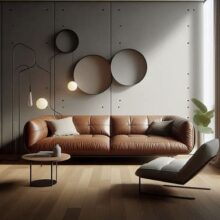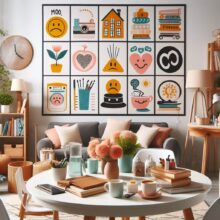How to Choose the Perfect Color Palette for Your Home

How to Choose the Perfect Color Palette for Your Home
Introduction: Did you know that the colors in your home can influence your mood, productivity, and even your relationships? Choosing the right color palette is more than just a matter of aesthetics—it’s about creating a space that reflects your personality and meets your needs. In this article, we’ll explore the psychology of color, practical tips for selecting a palette, and how to apply it to different rooms in your home. By the end, you’ll be ready to transform your space with confidence.
The Psychology of Color
Colors have a profound impact on our emotions and behavior. Warm tones like red, orange, and yellow can evoke feelings of energy and warmth, while cool tones like blue, green, and purple tend to be calming and soothing. For example, hospitals often use soft blues and greens to create a serene environment, while restaurants use reds and yellows to stimulate appetite. Understanding these effects can help you choose colors that align with the purpose of each room in your home.
Warm vs. Cool Tones
Warm tones are ideal for social spaces like living rooms and dining areas, where you want to encourage interaction and energy. Cool tones, on the other hand, work well in bedrooms and bathrooms, where relaxation is key. For instance, a study found that people sleeping in blue rooms reported better sleep quality compared to those in red rooms.
Principles of Choosing a Color Palette
One of the most popular design principles is the 60-30-10 rule, which suggests using 60% of a dominant color, 30% of a secondary color, and 10% of an accent color. This creates a balanced and harmonious look. Lighting also plays a crucial role—natural light can make colors appear brighter, while artificial light can alter their tone. For example, a north-facing room might benefit from warm hues to counteract the cool light.
Popular Color Schemes
- Monochromatic: Uses varying shades of a single color for a cohesive look.
- Complementary: Pairs opposite colors on the color wheel for a bold contrast.
- Analogous: Combines colors next to each other on the color wheel for a harmonious feel.
Room-by-Room Guide
Living Room: Opt for neutral tones like beige or gray as a base, with pops of color in accessories like throw pillows or artwork. For example, a gray sofa paired with mustard yellow cushions can create a modern yet inviting space.
Bedroom: Choose calming colors like soft blues, greens, or lavenders to promote relaxation. A real-world example is the use of sage green in minimalist bedrooms, which creates a tranquil atmosphere.
Trends and Innovations
Earthy tones like terracotta, olive green, and warm browns are currently trending, reflecting a desire for connection to nature. Additionally, eco-friendly paints are gaining popularity, offering sustainable options without compromising on quality.
Common Mistakes and How to Avoid Them
One common mistake is ignoring the undertones of colors, which can lead to clashing schemes. For example, pairing a warm beige with a cool gray can create visual discord. To avoid this, always test swatches in different lighting conditions before committing.
Conclusion
Choosing the perfect color palette for your home is both an art and a science. By understanding the psychology of color, following design principles, and considering the function of each room, you can create a space that is both beautiful and functional. Ready to transform your home? Start experimenting and share your journey in the comments below!



